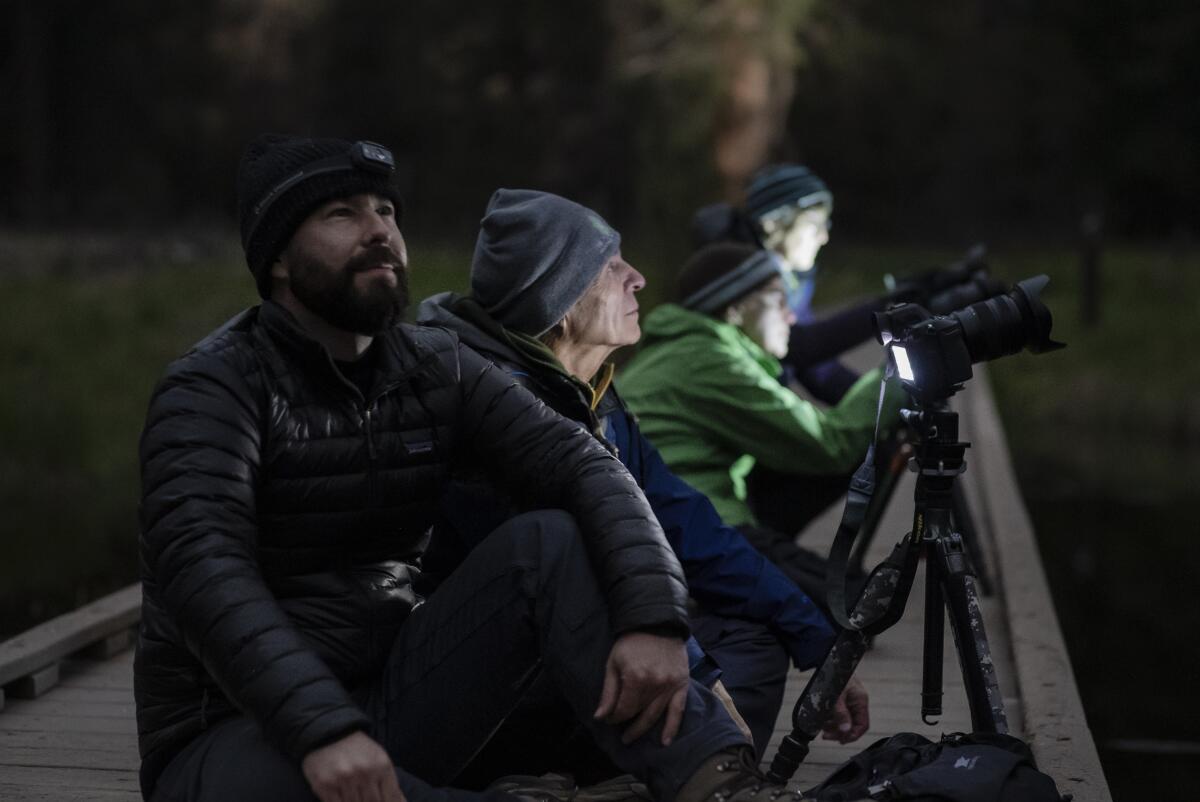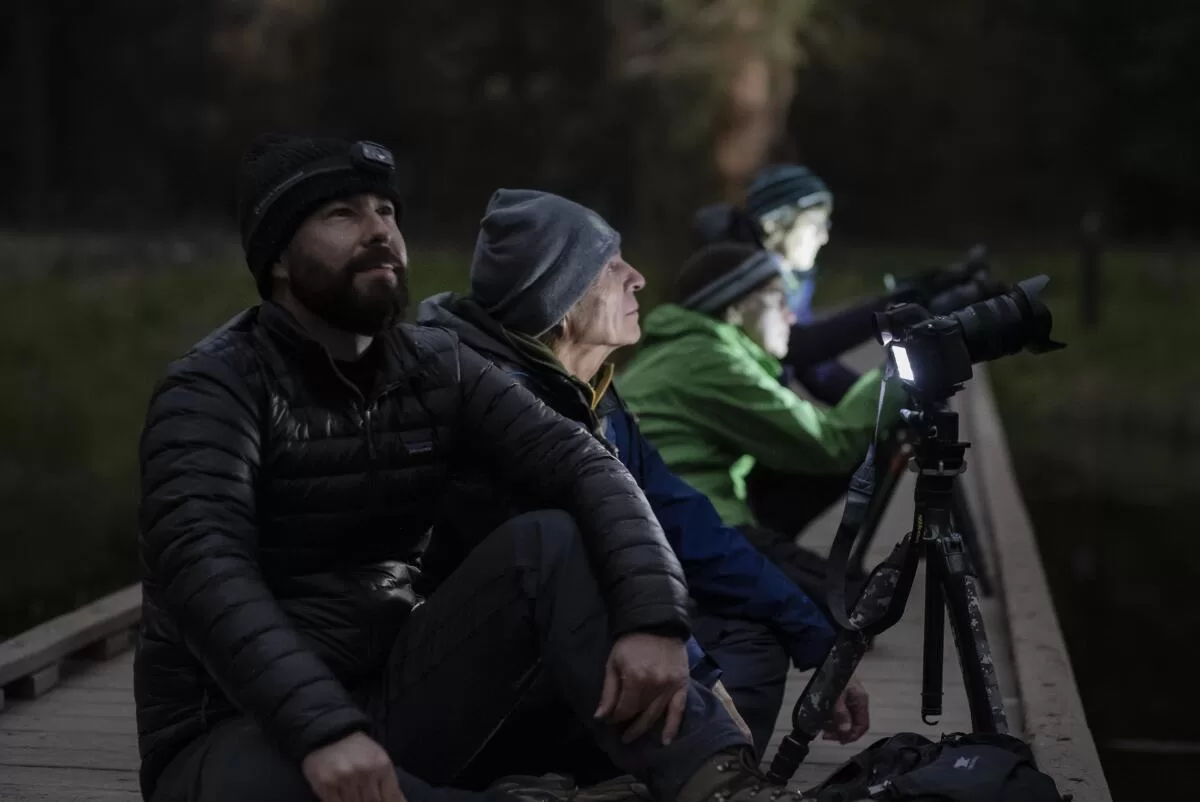“It’s cloudy, clearing later,” he said. “I would not expect to see anything yet.”
This was no chance meeting. A couple of years before I had discovered Hawkins’ website, where he posts photos, videos and very precise predictions of the phenomenon that had lured us to this place, at exactly this time: moonbows.
Naturalist John Muir called them lunar rainbows, or spraybows, revealed by a full moon’s light. Roaring spring and early summer waterfalls in Yosemite National Park make the central California destination one of the few spots on Earth to see them. The next viewing opportunity is May 21 to 25.
Moonbows haven’t realized the popularity of the park’s firefall each February, but visitors are gaining awareness. As we navigated the paved trail in darkness to Lower Yosemite Fall , we passed clumps of walkers going in the other direction, evidently discouraged by persistent clouds. At the base, some 25 were gathered in small groups, many behind a bend sheltering onlookers from the falls’ jet-loud spray.
Muir described the Yosemite Falls’ roar as “fine, savage music,” and Hawkins spoke movingly of how the falls, especially in the upper stretch, maintained a voice, even a presence. Having seen spectacular photos by him and others, my wife, Mica, and I impatiently waited for the moon to reflect the sun’s light on the falls. As did others.

(Alex Pulaski)
One photographer showed me a quarter-moonbow image he had captured 20 minutes before during a cloud break. Another, Eric Krapil, 28, from Laurel, Md., shared a full-arc moonbow photo from the night before, captured on his cellular phone.
“We got lucky,” he said. “Some guy walking past us at the lodge said, ‘Do you want to see a moonbow?’”
We certainly did on this night. And a few minutes later, as the yellowish moon briefly shouldered through the haze, Hawkins pointed to a rock. There, he said, a corner of the moonbow begins.
And I saw it: A quarter arc at best, ghostly white in the moon’s faint light. Not everything I had hoped for, but as we walked back later I thanked Hawkins for helping us see that glimmer — a hint of what might come the following nights.
Yeah, he said. A thoughtful pause ensued.
“That was,” he continued, “the most pathetic moonbow I’ve ever seen.”
Before 2007, nobody was precisely sure when and where moonbows would appear at Yosemite. But a team of researchers from Texas State University harnessed computers to meld topography, geometry and astronomy to accurately predict the moonbows’ appearance and published their findings.
Hawkins first visited the park that same year and became mesmerized by its beauty — particularly after seeing a moonbow in 2011. He started doing his own modeling, and his website debuted in 2018. It’s a labor of love — there are no ads, and he doesn’t do tours or hawk T-shirts.
What he does do is help other seekers. Anna Smits, who lives and works in the Yosemite Valley, saw her first moonbow during the pandemic. The park was closed to visitors, but Hawkins still shared his calculations. Now, Smits — both an avid photographer and outdoorswoman — occasionally pushes the envelope to find more elusive moonbow shots.
What does that entail? One night, that involved setting an anchor and rappelling about 15 feet to a ledge near Upper Yosemite Fall. Another time, she set her alarm for 1:30 a.m. for a hike in bright moonlight to Vernal Fall. It was so cold that the condensed spray solidly froze her tripod.
“It’s such a rewarding experience,” she said. “It really lights me up just thinking about sitting in the spray and watching this moonbow cross in front of you.”
That visual reward eluded us on the subsequent two nights of our visit last month. Daytime blue skies surrendered to clouds at night. Hawkins had warned me that first night that nothing was guaranteed.
“Prepare to be enthralled by the scene before you but also frustrated by how difficult it is to shoot,” he said. “A lot of things are working against you — it’s cold, it’s wet, the lens has to be dried off, you can’t use auto focus. You just have to be patient and work through solving all the problems.”
And when the moon is hidden by a curtain of clouds, you comfort yourself with the memory of the falls’ voice and a glimmer of the show waiting when you return.
What is a moonbow?
Simply put, it’s a rainbow seen at night, produced by the light of a full moon reflecting off droplets of water suspended in the air. But humans struggle to detect color at night, so — as with the northern lights — they usually appear white to the naked eye. Photographs, especially with timed exposures to allow more light, render them in full color, just like a rainbow.
Is Yosemite the only place to see moonbows?
No, but there are very few waterfall sites where they can consistently be seen. They include Cumberland Falls in Kentucky and Africa’s Victoria Falls, at the Zambia-Zimbabwe border.
When are the best dates, times and locations to see Yosemite moonbows?
They are best observed on the five nights around the full moon. Hawkins has calculated peak 2024 viewing dates and specific hours by location (Upper and Lower Yosemite falls and Glacier Point) for the next viewing window of May 21 to 25 at his website. Best dates for the following full moon, with his time calculations to follow later, are June 19 to 23.
Is any special gear needed?
Useful items include comfortable walking shoes, a rain poncho if viewing near a fall’s base, cloths to dry lenses and cameras, a tripod for longer camera or smartphone exposures and a headlamp or flashlight (red-light settings are preferable for not disrupting night vision). Weather apps such as Clear Outside predict hourly cloud cover. For the super-advanced, apps such as Photo Ephemeris and Planit Pro will help precisely calculate moon positions (and much more).
Are Yosemite National Park reservations required?
Sometimes. Until June 30, daytime (5 a.m. to 4 p.m.) park entry reservations are required on weekends and holidays. From July 1 to Aug. 16, they are required daily for the same time periods. Those with in-park camping or lodging reservations will be granted park entry. Full rules and a reservation link can be found at the National Park Service’s website.
Is it risky looking for Yosemite moonbows at night?
We didn’t find it daunting. Lower Yosemite Fall is just a 10-minute walk from Yosemite Valley Lodge, where we stayed. Cook’s Meadow, with its broad view of Yosemite Falls, is also nearby, but we decided to drive, largely because dense cloud cover obscured the moonlight. Both Hawkins and Smits counseled using common sense in seeking more remote locations. It’s worth noting that the intrepid Muir, who never shrank from a challenge, almost died one night while chasing moonbows behind Yosemite Falls near Fern Ledge; he escaped drenched and numb from a “wild bath in moonlit spray.”
